
24
Tax on Tampons
Texas bcomes the 24th state in America to remove the luxury tax on feminine products
5
Fall Upcoming Events
Fall events like spirit week and coffeehouse are coming up!


Texas bcomes the 24th state in America to remove the luxury tax on feminine products
Fall events like spirit week and coffeehouse are coming up!
When students and faculty walk into any Upper School bathroom, they are greeted by free menstrual products generously stocked on the sink counter. However, for many Texas women, menstrual products create financial stress on already tight budgets. To combat this problem, the Texas State Legislature passed SB 379, removing the luxury tax on feminine hygiene products –commonly referred to as the “tampon tax.”
Texas is the 24th state to remove the tax. Minnesota was the first to remove the tax in 1981 when the removed taxes on all health products.
State Senator Joan Huffman (R) spearheaded and sponsored the bill.
“ It’s a good step. It’s a small baby step in the right direction”
Francine Ly Democratic candidate
Huffman did not respond to a request for comment.
Francine Ly, a Democratic candidate running for the U.S. House seat for Congressional District 24, said she
believes while Republican lawmakers are open to economic measures that would benefit women living below the poverty line, she does not think that mindset will expand to issues like healthcare.
“The reason that this bill received bipartisan support is because both parties understand this is a woman’s issue and it’s the right thing to do,” Ly said. “It’s a good step. It’s a small baby step in the right direction.”
The bill also removes taxes on diapers, baby wipes, bottles, maternity clothes and breast pumps.
Despite the support for this bill, Ly does not believe current lawmakers will extend this support to reproductive rights.
“They think they are advocating for an unborn child, instead of advocating for the woman,” Ly said. “I do not believe this will lead to more women’s health advocacy in the Texas legislature. This was an economic issue. If you are spending money on taxes, you have less money in your pocket. That’s why they passed it.”
Upper School students are doing their part to combat period poverty with the TeenAge Communication Theater (TACT), run by Planned Parenthood.
TACT puts on skits highlighting teen health issues like pregnancy, mental health, STI prevention, birth control, stress management, bullying and more.
Senior and TACT member Lauren Shaw said that menstrual hygiene activism is important because not everyone
receives proper health education, especially in Texas.
Shaw also believes understanding menstrual health is important for taking care of personal well-being and feeling comfortable and feeling secure.
Many students are involved in TACT, which is currently organizing a period product drive in January. The menstrual hygiene products donated will go to the Planned Parenthood center in El Paso.
During TACT performances, “We just go in and TACT team leaders give an opening about TACT’s mission. Then, we perform the skits,” Shaw said. “At the end, we do a Q&A with the audience about what they saw and what’s important to note.”
Teen theater has a long history as a form of communication. The concept originated in New York City in 1973.
The family life division of New York Medical College was trying to find ways to communicate with teenagers about
“Never back down, never what?”
“Never give up.”
As junior Aryaa Phadke completed yet another mile of her Cross Country workout, she nearly tumbled to the ground, the sound of her coach’s enthusiastic remarks almost as unbelievable as the heat she was running in.
As her sight began to blur, she began to question whether she’d be able to complete the workout while the scorching sun beat down mercilessly upon her. Phadke is one of many individuals who have been impacted by the excessive heat of the 2023 summer.
Besides her, other athletes and people who spend substantial amounts of time outside – like maintenance workers - must often look for creative ways to adapt to the heat.
This year’s scorching temperatures officially made the summer of 2023 the second hottest Texas summer ever, according to the Texas Tribune.
The notorious Texas heat, which the Tribune says killed 279 people in 2022, is not new to the state, as it last recorded its hottest temperature of 120 degrees back in 1994.
However, while the highest temperatures may not be increasing, the fre-
quency of days above 100 degrees due to climate change has greatly contributed to the present heating crisis in Texas.
Additionally, in large Texas cities such as Austin, Houston, and Dallas, the impacts of the excessive heat are often exacerbated due to the “urban heating island” effect which, according to the Environmental Protection Agency, is a phenomenon that occurs in cities because of many surfaces that absorb heat and release it.
AP Environmental Science Teacher Jessie Crowley said larger cities’ temperatures are often higher than those of rural areas due to the urban heating island.
“Most of the surfaces that we make don’t bounce back light or have a low albedo,” Crowley said, referencing an object’s ability to reflect heat. “Instead of deflecting that energy, surfaces often just absorb it and then radiate it back out into space, and we’re now feeling the effects of that.”
While many scientists have shown the impacts of this heat when discussing climate change, student-athletes around Dallas feel the impact of the excessive heating on their daily practices.
As a result, athletics programs of schools in the area reacclimated their

issues that were pertinent to their age group. As a way to connect to teenagers, the staff launched the first teen improvisational and educational theater troupe.
In 1982 Planned Parenthood of North Texas started TACT as a program to combat the alarming rate of teenage pregnancy and STI infections.
Saxon Mosely, Form III and TACT team leader, believes the removal of the tampon tax will be beneficial to girls in Texas.
“If you have a period, these products are a part of your life’s essentials,” Moseley said. “The ‘tampon tax’s’ removal is awesome and will really help overall.”
For more information on joining TACT, email tact@ppgt.org.
schedules and the locations of their practices.
In cross country, for example, a sport that takes place outdoors, coaches have had to adjust certain aspects of practices for the safety of athletes.
According to sophomore cross country runner Gabrielle Carter, while runners often train through the humid heat regardless of the temperature, on occasion, the heat becomes too intense for the athletes.
“We had some days when we were supposed to be outdoors the whole week, but we ended up going in the morning every single day [instead],” Carter said.
For junior Jayna Khatti’s Field Hockey team, however, while several games were shifted, many practices were canceled altogether due to the heat. Because of this, her coach had to look for new ways to ensure the athletes could continue practicing.
“We just haven’t been able to get out on the field as much,” Khatti said, “and we haven’t been able to do as many of the drills that really help us improve as a team, but we made the most of it by going swimming instead as part of our practices and going into the weight room more often.”
Besides its impact on athletes around Texas, the heat has also tremendously impacted those who spend hours every day working to maintain greenery and buildings.
As Hockaday has about 88 acres of land, those maintain its campus had to do their jobs under the sun every day.
José Sanchez, who works in facilities maintenance at Hockaday, noted that this year felt particularly blistering.
“It was hotter than the past five years,” Sanchez said. “Everyone was drinking way more water and taking more breaks than usual.”
However, as the temperatures begin to cool and summer winds down, athletes and those who work in maintenance alike anticipate the benefits of the cooler weather.
“The cooler weather makes you more excited for workouts and long runs,” Phadke said. “The heat makes you really tired and dehydrated all the time.” Sanchez looks forward to the cooler weather as well.
“We’ll have more energy, and I feel like we’ll be more comfortable outside, too,” Sanchez said. “And hopefully, next year the weather will be better!”

Every month, the Fine Arts Department hosts a joint Coffeehouse event with St. Mark’s. The event serves as a way for students from both schools to perform as well as watch other performances. Each Coffeehouse has a different theme, and the October one is Halloween. Students attend to showcase their costumes and their talents.
Halloween Coffeehouse – Oct. 14 Junior Patron’s Guild to Harry Potter and the Prisoner of Azkaban – Oct. 29
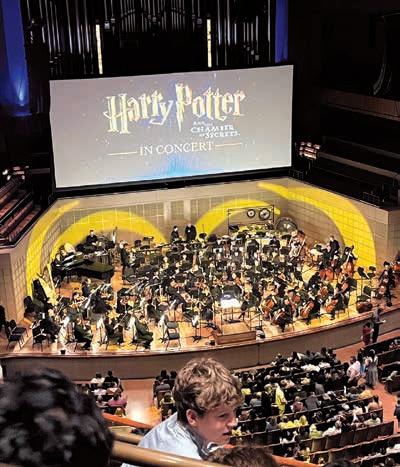
The Junior Patron’s Guild takes students to different events throughout the year. This October, they will attend the “Harry Potter and the Prisoner of Azkaban” performance at the Myerson Symphony Center from 1:30 – 6 p.m..
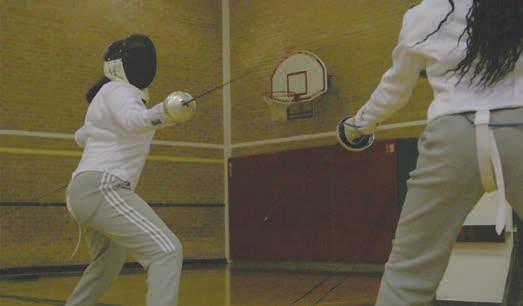
The fencing team typically hosts an annual invitational in October. Hockaday invites teams from other schools and organizations to attend the competition and compete with the students on our fencing team.

Hockaday hosts an annual coat drive each fall of the school year to collect jackets for donation to underprivileged areas in Dallas. The drive provides an opportunity for students to give back to our community and gives a little warmth to kids during the winter.
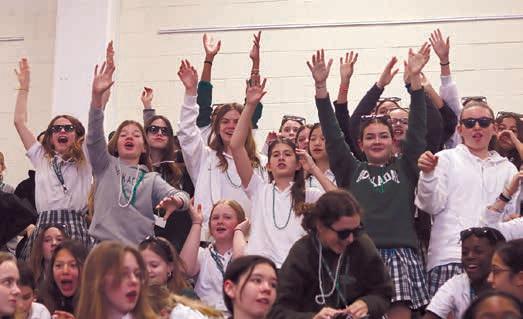
Come cheer for and support your friends and fellow athletes at the October Spirit Rally as they prepare to compete in their SPC events. The previous week will be filled with different free dress days to inspire our athletes.
As schools across the nation resume fulltime operations, school officials have seen an increase in flu and COVID-19 cases, prompting nationwide attention.
Upper School Health Coordinator Adaku Ebeniro said that lax behavior surrounding mask-wearing and taking proper precautions could be causing the uptick and mutation of a new viral strain.
“When we are coming back from a holiday, we’re putting kids back in schools or putting parents back in work,” Upper School Epidemiology Teacher Carol Taylor said. “The more exposure you’re getting to more people, the more likelihood that you get sick.”
In addition, Taylor believes the change in seasons could potentially weaken the immune system, although some may be more impacted than others.
“The change in seasons, specifically cooler temperatures, impair critical immune system proteins which allow viruses to reproduce rapidly in the respiratory system leading to more illness,” Taylor said.
As new COVID variants circulate, scientists seem concerned about one in particular. According to the New York Times, while EG.5 was the dominant variant in August,
a much less widespread variant BA.2.86, nicknamed Pirola, is alarming scientists due to the many mutations it carries.
“The more hosts the virus has, the faster it can spread, which makes the virus stronger,”
Ebeniro said.
On Sept. 11, the Food and Drug Administration approved the new COVID booster shot, which is similar to previously approved formulas, but updated to target the XBB variants that became prevalent last winter.
According to CNN, lab experiments completed by two teams of scientists concluded that vaccinated and infected Americans have a good, if not better, chance of fighting off the highly mutated Pirola compared to currently circulating offshoots of the XBB variant.
“Booster shots are meant to build up the body’s defense against COVID,” Ebeniro said. “You can still be infected, but it just helps the antibodies to continue growing and have a better response in your immune system. If a person does become ill, those antibodies can find it faster, and reduce the risk of it becoming severe.”
In addition to taking boosters, Taylor believes there are other ways to stay healthy, and one that often gets overlooked is sleep.
“I think you often hear students

saying they’re not getting enough sleep,” Taylor said. “I think when you come to school one day and you’re exposed to somebody who is sick, your body’s ability to fight that off has everything to do with the level of strength that you’re at.”
She adds that maintaining a healthy diet and exercising can also help to improve the immune system.
Vitamin C, for example, stimulates

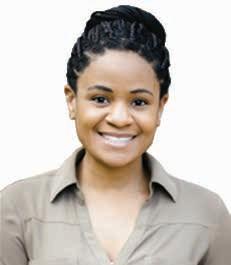

Q - Where were you before Hockaday?
A- I got my law degree from Columbia University and my bachelor’s from the University of Tulsa. I practiced law for 26 years before teaching at the Trinity School in Midland before coming to Hockaday.
Q - What is your favorite song?
A - “Thunder” Road by Bruce Springsteen.
Q - What is your favorite thing to study?
A - I am a Supreme Court fanboy. I like to study situations in history when the court has gotten it very wrong and why.
Q - Where were you before Hockaday?
A- I received my bachelor’s and master’s degrees from Georgetown College in Georgetown, Kentucky, and my doctorate from Maryville University in St. Louis. After, I taught fourth grade for six years in Kentucky, then moved to Texas and worked at Baylor University in the Title IX (Equity, Civil Rights and Title IX) Office.
Q - What is your favorite movie?
A - I am a movie fanatic and used to work at a movie theater. My favorite movie is either “Aladdin” or “Now You See Me.”
Q - Why did you decide to come to Hockaday?
A- I got to know Hockaday through interacting with colleagues from other schools, and the school was like where I came from, so I thought it would be a good fit.
Q - What is your favorite thing to teach?
A - I really love teaching literature, but I have not been able to for the past few years, and I miss it.
Q - What is your favorite song?
A - I love anything by Whitney Houston
the activity of white blood cells, thus boosting immunity.
“The healthier you are the better your chances are of fighting off illness,” Taylor said. “So be mindful of living a healthy lifestyle and paying attention to your routines around diet, exercise, and sleep.”

Q - Why did you decide to come to Hockaday?
A- I had heard of Hockaday and its prestige, so when I heard there was an opening for a Latin teacher, I decided to try for it.
Q - What is your favorite thing to teach?
A - I love to teach Cicero’s “First Catilinarian Oration” because it’s so dramatic and extra.
Q - Do you have any pets?
A - I have a dog named Athens

Q - How are you going to implement the feedback from students during the StuCo Stop-by?
A - We are going to start by sorting through all the student responses at our next meeting, and then we will do some brainstorming on how we can solve some of these problems. We plan on choosing a few main issues to focus on this year and intend to pocket the rest for the next StuCo president. We’ll start working immediately and then look through the rest to see what else needs to be done.
Q - How are StuCo meetings run?
A - We meet every Day Three for Exec StuCo and every Day Six for Big StuCo, and the meetings take place on the second floor of the LLARC in the boardroom. The agenda is different every day, but we typically go through board announcements, where each board tells us more specifically what they need from Big StuCo, and then we go through large issues as a group.
Q - Other than reading the meeting notes, are there any other ways students can get involved?
A - There’s a feedback box next to the StuCo board. I also want to bring the StuCo feedback form, and we are considering putting a QR code on the board in the hallway that would link to it.
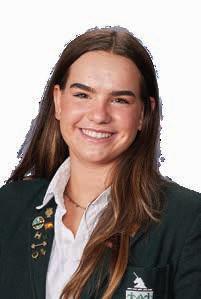
Q - What is your role within Big StuCo?
A - I go to meetings with my board, and we plan things mainly with the Athletic Department. I primarily help contribute the Athletic Board’s perspective to Big StuCo. During Big StuCo meetings, all the board chairs talk about what each board is planning and how Big StuCo can support that.
Q - What are the plans for the Powderpuff so far?
A - At the moment, it’s still in the works, so nothing is concrete yet. We’re thinking about creating a competition where any Upper School student can decide whether they want to participate, and whoever participates will form a team with other students in their grade level. We plan on creating a bracket and will crown a form as a winner. It’s going to be flag football, and we’re looking to see how we can include faculty and St. Mark’s students in any capacity that we can.
Q - What are some of the upcoming events you have planned?
A - We have a Spirit Rally for the SPC fall season. We’re also trying to work with the middle school Athletic Departments, including Middle School and Upper School sports, and creating more community between JV and varsity teams. We really want to do events across grade levels, like a Powderpuff game in the spring. We are brainstorming ideas, such as meet and greets between captains and middle schoolers so they can better prepare to go into varsity sports.
Q - What are your goals for the year?
A - Our biggest goal is to build stronger bonds within the athletics community.

New athletic facilities
Q - What are some goals you hope to achieve this year?
A - I personally want to bring back the service dogs. I don’t know how plausible that is, but I will work my hardest to get them here. Although I believe the counselors brought them to campus once last year, I want to bring them back more frequently.
Q - Where are the meeting notes posted?
A - Our Secretary, sophomore Courtney Buford, takes meeting notes and posts them on OnCampus. To access them, go to OnCampus, then click on “Groups” and then go to the StuCo tab.
Q - What’s the StuCo theme this year? How are you going to implement the theme?
A - The theme is “let it grow.” We want to promote growth this year and encourage daisies to grow to be the best people. We purposefully made the topic very broad so we can encompass a lot of different aspects of student life.
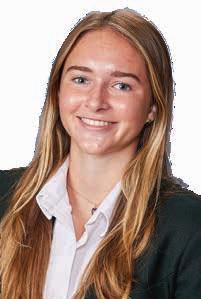
Q - What are you currently planning?
A - The big event that we plan every year is the Winter Formal, so that’s been in the back of my mind. But for the past few years, we’ve been doing gingerbread contests and pajama days, so I want to keep traditions like that as well as think about new fun things to do.
Q - How can students get involved with the activities board?
A - I feel like it’s sometimes hard to go to a school event that is just purely for fun. But it honestly makes such a difference to just show up to the mixer, get excited about Winter Formal and attend all the events for the other StuCo boards too. It has an effect that people don’t realize, and it helps us bond. Just be open to going to school events and carving out that time of your day, even when you’re busy.
Q - What did you hope to get out of the mixer, and now that it has happened, what did you end up getting out of it?
A - For the past few years, the mixers have been outside in Metzger, which is really beautiful, but I feel like it would be fun to have them inside.
I loved how the setup turned out at the Mixer, especially the blacklight, and everyone showed up dressed in theme! From my observations, the Hockaday, St. Mark’s and Cistercian students were all talking and even started up a volleyball match. I’m excited for that energy to carry over into future events like Hoco and WinFo. I want to give a big shoutout to all of the teachers, maintenance, SAGE and StuCo who all helped out behind the scenes.
Q - What was the brainstorming process for the mixer’s theme like?
A - We ask the reps from every grade and have them throw out ideas. Then, we vote on one unless it’s really leaning one way. Another other theme idea we had this year was Barbie, which was our runner-up.
new on welch
A look at what’s happening on campus

New students
Hockaday’s 148 new students are finding their way around and making friends. “I like that Hockaday is about a daisy,” new first-grader Madeline Conrad said.

New schedule
Upper School implemented a new schedule this year, with 100-minute classes and a free period after lunch named WIN, or “Whatever I Need.” “It is hard to sit through 100-minute classes, but I like the flexibility we have with a free period after lunch,” sophomore Jada Muhia said.
Album Review Fall Favorites
Four staffers review four new albums released in September and October.
The Big Sis/Lil Sis tradition has been around for many years in the Hockaday community. Every year, a senior is paired with a freshman in hopes for the two to create a close bond, and so that the senior can help guide the freshman throughout her first year of Upper School.
As a way for the seniors to pass on the torch to the freshman, this tradition strives to create a closer bond between the two grades. The Student Relations Board organizes the Big Sis/Lil Sis tradition. The SRB mission statement states that they “aspire to promote unity across all grades as well as ensuring the smooth integration of new students into the Hockaday community to create a more cohesive and welcoming environment.”
The board helps to pair the groups and plan activities throughout the year for the seniors and freshman.
“The seniors have a lot of wisdom after being here for so long and I think it’s really beneficial for them to kind of show their Lil Sis the way,” SRB Chair Gracie Little said. “It helps the Lil Sisses feel like they belong in Upper School.”
The process of making the senior and freshmen pairs starts before the summer.
“We made a survey, sent it out, and then over the summer I paired people up based on their interests,” Little said.
Seniors can request freshmen and vice versa, but if multiple people request the same person, Little pairs them based on shared interests. It took Little about eight to ten hours to pair everyone together. Sometimes, if there are more seniors than freshmen, seniors will share one Lil Sis.
For the reveal, freshmen waited in the theatre while the seniors lined up outside holding posters with the names of their Lil Sisses. The freshmen then walked out of the theatre to find their Big Sisses holding posters with their names on it. The posters are hung on the freshman lockers and are usually personalized with the Lil Sisses’ interests and advice from their Big Sisses.
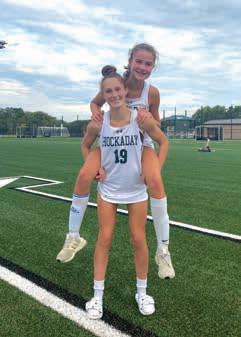
The Student Relations Board plans to have one Big Sis Lil Sis event every quarter for a total of four events throughout the year. This year, they plan on having a DJ at the events, something that hasn’t been done in two years.
Little hopes that the Big Sisses and Lil Sisses will hang out frequently.
“I hope that maybe the Big Sis can keep up with the Lil Sis as she goes through high school, even when the Big Sis is in college,” she said.
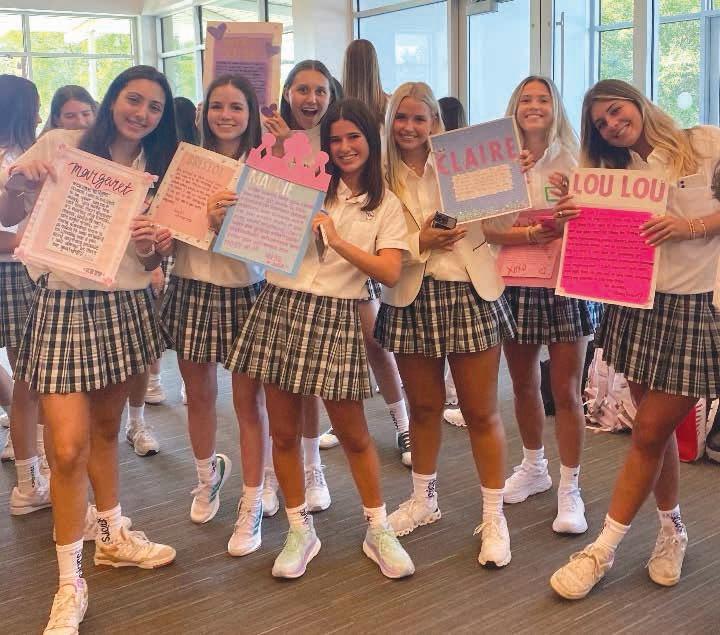
Senior Caroline Warlick and freshman Sophia Fagelman are a Big Sis Lil Sis pair. Warlick and Fagelman are both on the varsity field hockey team, and they also both play lacrosse.
Both Warlick and Fagelman are excited to be a part of this tradition.
“I love being able to partner up with a freshman and get to know them better,” Warlick said. “It’s exciting to unite everyone, especially with the seniors exiting and the freshmen coming in.”
“Being a freshman it’s really nice to have someone that’s already been through high school and like a friendly face in the hallway,” Fagelman said.
When Warlick was a freshman, the world was in the thick of COVID-19 pandemic. Despite these conditions, she was still able to form and maintain a great relationship with her Big Sis. Warlick had been friends with her Big Sis since Lower School, and she was someone who Warlick could talk to and receive guidance from.
“I definitely learned a lot from being a Lil Sis.” Warlick said.
At the Big Sis reveal, Fagelman was surprised to find out who her Big Sis was. She had requested Warlick as a Big Sis because one of her friends recommended them to be together.
“I couldn’t find my sign at first, but when I did, I was surprised because I didn’t know I would actually get her.” Fagelman said.
Warlick decorated a poster for Fagelman. Along with Fagelman’s name, Warlick attatched an envelope with cards in it that are designated to be opened on specific important days, such as the first day of school and first SPC game. After the reveal, Warlick took Fagelman on a tour of the Upper School.
“It was so much fun because I’d never seen that part of the school before.” Fagelman said.
Warlick and Fagelman both enjoy being on the field hockey team together.
“Being on the same sports team definitely helps our relationship,” Warlick said. “I feel like for some of my friends and their Lil Sisses, they have to schedule specific things, but we see each other every day.”
Warlick and Fagelman both said that they feel that being on the same athletics team bridges the gap between ages and they feel like friends and teammates rather than a senior and freshman.
“The Big Sis Lil Sis tradition helps to unite everyone,” Warlick said.
Flip to page 11 to see what Staff Writer Emily’s fall staples are.
Editor-in-Chief Harper Harris is a pop culture fanatic, and she’s here to address what’s trending.
Last April I heard the rumor about Timothée Chalamet and Kylie Jenner dating and thought it was fake, but months later in September, they went official at Beyonce’s Renaissance World Tour in Los Angeles.
People Magazine reported that the duo has been dating for over six months and that the relationship is “fun and uncomplicated.”
While I was happy for them, I was still confused about why they were dating. While complaining to my advisory about the situation, I stopped myself and thought: “Why do I care, and why does the public feel the need to weigh in on celebrity relationships?”
Seemingly weird couples have been around forever. Examples include Jenner’s sister Kourtney and Travis Barker, and Kim Kardashian and Pete Davidson, who are now broken up. These couples, might seem weird, but they appear to make each other happy at least for a while and the public should support them.
The public’s infatuation with celebrity relationships is a relationship in and of itself. We love to gossip and feel as if we know the celebrity couple personally. We idolize them through social media, so we get more invested than we really should. The public watches and indulges in celebrity content, so they feel that they have the right to scrutinize and question their relationships.
All over pop culture, the idea of a perfect, loving relationship lives everywhere, from Disney movies to “The Bachelor.” So, most of us are conditioned to want and idealize happy, longlasting couplings, making us upset when we see a celebrity breakup or a relationship that looks off. Plus, people tend to either envy, look up to or see something of themselves in celebrities, making them subconsciously root for the couple to last.
I realized my fit about Jenner and Chalamet was insignificant. If they make each other happy and want to date, they should be able to, without it being a problem. At the end of the day, celebrity relationships are none of our business whether they post about it publicly or not—the people involved are the ones in the relationship, living their lives together, while we are simply bystanders and fans.
eloading my TikTok
R“For You” Page for the hundredth time that day, I anxiously wait for my favorite videos of the year to appear. Every August, hashtags like “#BamaRush” and “#SororityRush” receive millions of views on all social media platforms.
As a rush fanatic, I have loved following my favorite sorority icons on their journeys to find new sisters. Sorority rush, specifically at the University of Alabama, has become so popular that many TikTok users refer to each year of rush as a different season, similar to TV shows. One “Season 2” character that has gained a huge following in recent years is Kylan Darnell. With the catchy tagline, “I hope you have a great day, not just a good day,” she has quickly become known as the “Queen of Bama Rush,” with fans praising her positive attitude and cheery spirit.
Sorority recruitment, or more commonly known as sorority rush, is a process that can last anywhere from three days to three weeks in which potential girls are recruited to join a national chapter of a sorority.
Many Hockaday alums have rushed and offer advice for preparation and success during the process.
“At UT, they provided us with Texas Panhellenic rush bags, so there was no competition over who had the cooler or cuter bag,” Thurman said. “I added a pink monogrammed keychain. That way, it was more personalized to me and easier to find among the hundreds of Texas Panhellenic bags at the sorority houses.”
Thurman added that there are certain essentials you should carry in your rush bag.
“In my rush bag, I had a water bottle because it gets really hot running around outside, especially if you rush in the South like I did.” Thurman said. “I also brought a notebook to write notes in, a portable charger, makeup for touchups and mints so I could pop one in before I walked into each house.”

First and foremost, it all starts with your outfits. Payton Thurman ’22 and Zeta Tau Alpha member at the University of Texas at Austin said she started by personalizing her rush bag.


NIn the Preference round, houses invite possible members back for interviews.
After the bag, you need to consider your shoes and clothing.
Alexa Welch ‘23, Tri Delta member at the University of Alabama, said rush involves casual and dressier days.
“Most people wore athletic clothes on the first rounds of rush because it doesn’t need to be fancy,” Welch said.
“Where to elevate your outfits is during the Preference round, where you start to wear dresses and wedges, and the houses can really see your personal style come to life.”
“When we were required to wear heels or wedges, I brought sneakers or flip flops in my rush bag so I could quickly throw them on and run to the next house,” Welch said. “The days are so fast paced you want to make sure you can wear or bring something comfortable to get from house to house.”
Thanks to alums Thurman and Welch, we know what to bring and wear to recruitment. However, this presents the question: How do we act and present ourselves while we are touring the houses?
Harper Clouston ’15, a former president of Tri Delta at Emory University in Atlanta, said there are some common traits sororities seek.
“Although each sorority is slightly different on what kind of girl they are looking for, all sororities are looking for girls who have positive attitudes, bright personalities and who are genuinely excited about

the houses they are attending,” Clouston said. “Some things to avoid are not staying true to yourself or just talking about things you think they want to hear.”
Clouston added that some important topics to mention are community service activities you’re involved in, extracurricular clubs, sports and fun things you like to do in your free time. Talking about interests like these might make you stand out among other potential new members.
Besides her “dos and don’ts,” Clouston also reflected on the beneficial effects the Tri Delta sorority had on her during her college and professional life.
“The close friendships I made with several of the Tri Delts has been so impactful in my college and post-graduate life and I’m so happy that I ended up rushing during college,” Clouston said.
 by Larkin Clouston
by Larkin Clouston
Arts & Life Editor Alexandra Dassopoulos is a self-proclaimed fashionista, ready to report the latest news of the fashion world.
ew York Fashion Week (Sept. 7-13) has come and gone, with 74 runway shows and a variety of other events. Brands brought new trends to the table, but more importantly, inclusivity was at the forefront.
Selkie, which became known for its fairytale-esque “Puff Dress” in 2021, showcased a diverse set of models. The brand featured women in an array of sizes and ages, but also abilities, making it unlike many other high-end brands at NYFW and setting an example of what it looks like to be truly inclusive.
Palomo Spain, an up-and-coming genderless fashion brand, included a mostly masculine cast in delicate feminine clothing at their NYFW show. Alejandro Gómez Palomo, the
head designer and creative director, is championing non-binary clothing in the industry and challenging societal constructs. Going further than simply men in skirts or pearls, Palomo’s designs included chiffon and lace camisoles, regal corsets and feather headdresses.
Long criticized for its lack of body diversity, Victoria’s Secret has been rebranding and augmenting its inclusivity since 2019. But at NYFW this year, Victoria’s Secret took another step to further inclusion, creating adaptive products for disabled customers. The undergarments that debuted feature magnetic closures, instead of hook-and-eye, and front-facing adjustable straps, providing greater accessibility and reach.
Remi Bader, a plus-size
influencer pushing for inclusivity in the industry, found that Tommy Hilfiger took the “extra step” to make her feel confident and represented. At their NYFW brunch, the brand custom-made Bader an outfit, even though they already carry her size.
“They took two skirts and put them together and cut off a coat to make a cropped jacket, and it turned into this outfit that’s so me,” Bader said in a People interview.
effort to make someone feel good, it
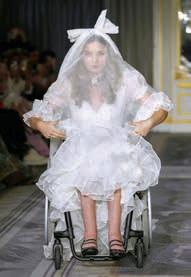
“If more brands just put in the

Bader echoes the hopes of many: for brands in fashion to consider and represent all body types with their designs, rather than place inclusivity as an afterthought. She also captures the fact that it’s essential for every consumer to feel genuinely connected to and confident in the clothes they buy. Though there’s still a long way to go, this NYFW certainly demonstrated progress in inclusivity.

Let’s be honest – before Drake announced the devastating postponement of the “For All the Dogs” album release, we were all counting down the days until Sept. 22. So, Drake, instead of mourning over the news, I’ll “WAIT FOR U” and shift my excitement towards the night’s less-anticipated album drop: Lil Tecca’s “TEC.”
New York rapper Lil Tecca, blowing up in 2018 after the release of hit single “Ransom,” released his third full-length album after “falling off” a few summers ago. Tecca’s prior projects provided a limited glimpse into his full potential. Simply put, they were failed attempts at replicating his initial 2018 peak.
“TEC” unveils the rapper’s growth from his previous works as he claims his authenticity in his music. The album provides a respectable blend of all of Lil Tecca’s vibes – from slower beats to
60.1 million monthly listeners, 23rd in the world on Spotify, four-time Platinum album, Grammy winner Olivia Rodrigo.
On Sept. 8, Rodrigo released her second album, “GUTS,” containing 12 songs and lasting 39 minutes and 18 seconds. Out of these 12 songs, her two singles, “vampire” and “bad idea, right?” have been streamed 402,035,361 combined times since their releases in June and August.
She is best known for her angsty, emotional and relatable lyrics, while also coming across as a youthful, fun, careless teen. In her new album, she takes this energy to a whole new level with songs like “get him back!” and “love
never-heard-before sounds from the rapper. Because a variety of styles are offered, one’s opinion on the album depends on the version of Tecca they’re looking for.
Personally, I’ve been listening nonstop to “HVN ON EARTH,” a joyful track featuring rapper Kodak Black. In their first collaboration together, the duo’s flows gracefully complement each other, and their joint lyricism proves their affection for their significant others. Implemented throughout the track are catchy, high-pitched vocals from producer BNYX which, for me, were love at first listen.
On the track “Fell in Love,” Lil Tecca and Ken Carson reunite to emphasize their hatred for love, seemingly contradicting the lyricism in “HVN ON EARTH.” After Tecca’s 2019 Genius interview regarding his lyrics in
by Shifa Irfan | Staff Writer
I have only listened to a few Mitski songs in my life, but after listening to her new album, “The Land Is Inhospitable and So Are We,” I found myself wanting to listen to more.
Sitting at around 32 minutes, the album has 11 songs, including singles, “Bug Like an Angel,” “Heaven” and “Star.”
The first song, “Bug Like an Angel,” invites listeners into a promising album, with its bursts of angelic-like singing and a simple, but powerful melody.
“Buffalo Replaced,” is the next song and is just under three minutes and has few lyrics, making it seem like a filler song or transition to the next song, “Heaven.”
I like “Heaven” and its slow pace. The flutes and slow guitars complimented
On Sept. 29, Ed Sheeran released “Autumn Variations,” his sixth studio album and the first since his mathematical symbols series. A beautiful exploration of varied emotions, the album showcases the feeling of autumn and what the season represents on a deeper level.
After venturing into the pop world with his last albums, Sheeran returns to his signature folk/pop sound with “Autumn Variations.”
Every song includes some form of strings, courtesy of Aaron Dessner, who also worked with Sheeran on “Subtract” earlier this year. Dessner provides an evolution to Sheeran’s style, giving it a needed depth to support the existential
Mitski’s low voice, making it pleasant to listen to. It also had a nice outro with simple piano playing and ends on a high note with a flute.
The last song I enjoyed was “Star.” It starts very slow but has an instrumental piece that feels like it’s building towards a breaking point, but the song ends abruptly. I was dissatisfied with the ending because I thought the beat and the lyrics would match up, reaching some sort of climax towards the end, but this could have been an artistic choice, with Mitski wanting the listener to feel disappointed.
In almost every song, there is an instrumental solo including some kind of string instrument, like a guitar. I enjoyed these as they broke up the songs nicely but didn’t think it was
is embarrassing”.
Rodrigo has made a name for herself with her ballads, but where she really shines is in these fun, pop-funk style songs. These surprised me when I first listened to them because they were different than her established sound, but they did not disappoint.
However, Rodrigo still includes the emotional ballads she is best known for with songs like “making the bed,” “logical,” and “teenage dream.” While I was expecting an album full of songs like this, the strength of her voice and the depth of her lyrics blew away all my expectations. I believe she perfectly encapsulates the many complicated
feelings and experiences of being a teenager through her striking lyrics and unique melodies. Since this album came out, I have not stopped listening. While my opinion might be controversial, my least favorite song is “pretty isn’t pretty” because I don’t love the beat since it’s not necessarily fast or slow. My current favorite songs are “lacy” and the “grudge,” because of the lyrics and progression, specifically their choruses. Even though there are songs I like and dislike, I have the entire album favorited on Spotify. In my opinion, it may even be better than her first.
by Alexa Muñoz | Arts and Life Editor“Ransom,” it’s been widely accepted that the rapper doesn’t always mean what he says in his songs. Nevertheless, Ken Carson’s feature solidifies the more Opium Record Label inspired flavor that Tecca also experiments with in songs “Dead or Alive” and “Monday to Sunday.”
In a Genius interview following the release of “TEC,” Lil Tecca explains that he wishes to give people a glimpse at his real life through the album’s cover.
“I wanted to show people my style, show people what I like,” Lil Tecca said. “But also...I wanted to stand in front of all the stuff I’ve done, [to] show my growth.”
Through both the album art and tracks, Tecca achieved exactly that, and I look forward to seeing what future projects have in store for the rapper.

queries present in “Autumn Variations.”
Overall, Dessner’s sonics create an autumn inspired melody, perfect for listening to on a lazy Saturday morning while sipping a pumpkin spice latte.
Inspired by Edward Elgar’s “Enigma Variations,” in which the composer wrote every composition based on a different friend, Sheeran’s “Autumn Variations” centers around his friends’ experiences.
With this album, Sheeran offers insight into the difficult life changes he and his friends went through this past year. Writing from varied perspectives, he captures their views of the world, as well as his own.
The artist includes everything
necessary for every song.
from themes of deep depression and loneliness to the joys of new relationships and the contrasting despondence of heartbreak. Sheeran’s new tracks are unabashedly honest, a quality that has remained an important part of his music since his debut.
Overall, he beautifully executes a portrayal of complex emotions and experiences with unique melodies and incredible lyricism: his songs leave listeners satisfied by evoking both thoughtfulness and emotion.
Ed Sheeran’s ability to inject passion and experience into his music speaks for itself, and it surely provides enough reason to give his latest album a listen.
by Harper Harris | Editor-in-ChiefWhile listening, I also noticed that her voice was very soft and felt like her lyrics were getting drowned out by the instrumentals. In several of the songs, there were a variety of different sound effects, including dogs barking and insects flying. I thought these additions were interesting, but not needed since her voice was already getting lost. Overall, the album reflects Mitski’s consistent style from previous albums, which I think is perfect for background study music. While I probably will not listen to this album in full ever again, I enjoyed listening to an artist I didn’t know much about and added two of the songs to my playlists.
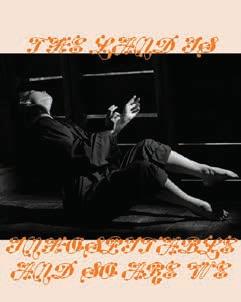
If you’re anything like me, when it comes to concerts, you probably spend more time picking out the perfect outfit than making plans or even getting the tickets. In the past few months, concert fashion has become an increasingly prominent aspect of the experience. Some people have even hand-sewn, painted or bedazzled pieces of clothing,
documenting the processes on TikTok or Instagram.
Fans use their concert outfits as an outlet to showcase their creativity and commitment to the performers. Some people dress up as specific lyrics or song titles and others match their outfits to the artist’s or album’s vibe.
Concert fashion peaked this past

When senior Paige Glowacki went to the Lana Del Rey concert, she was inspired to wear clothing that matched Lana Del Rey’s aesthetic. She wore a white skirt, pink corset top and tied matching pink bows in her hair.
“I chose an outfit with soft colors because I wanted to match Lana’s coquette, americana vibe,” Glowacki said. “I thrifted the top and thought it was perfect for the concert.”
spring with Taylor Swift’s “The Eras Tour,” where many fans dressed up to match their favorite albums. Many users documented their outfit-creation progress on social media and created specific audios to show off their outfits with. The “#erastouroutfits” hashtag on TikTok received over 1.4 billion views, and users on Instagram created
accounts to post pictures of outfits they saw at concerts.
Since then, concert fashion has remained prevalent. Some artists have begun to encourage dressing up for concerts, even requesting that fans wear certain clothing or colors.
“My outfit was not as exciting as most other ones I saw,” Cothren said. “But my two-year-old was very complimentary of it and made me feel great.” 1 3 2 4
Recently, Beyoncé’s “Renaissance World Tour” has inspired outfit trends among her fashionable fans. Beyoncé encouraged her fans to wear silver to the concerts that took place during Virgo season, which lasted from Aug. 23 to Sept. 22. Even after Virgo season ended, many fans still continued to wear silvery or metallic clothing.
Senior Alyssa Anderson attended the “Renaissance” tour in Houston. She and her family all wore silver and black clothing. Anderson wore black cowboy boots, a black skirt, sparkly silver top and silver jewelry.
“I wore a silver top to match the chrome, futuristic vibe of the album,” Anderson said.


Loud Luxury is a DJ and music production duo who specialize in dance music. Seniors Tarini Gupta and Caroline Stevens wore matching all-black looks to the Loud Luxury concert on Sept. 15.
“I tried to go for the all-black rave aesthetic with my outfit,” Gupta said. “Then, I sprayed silver body glitter all over the black clothing to give it some extra shine.”



Oct. 20 at 8 p.m.
The Studio at the Factory
Dr. Claire Cothren, Upper School English teacher, also went to the Beyoncé concert. She kept to the silver theme by wearing a silver velvet dress and matching silver dangling earrings.



Chris Stapleton Oct. 27 & 28 at 7 p.m. Dos Equis Pavilion
“Where
Chicken N Pickle is a new, innovative way to have fun while also enjoying some great food. Reminiscent of places like Top Golf, the venue has multiple pickleball courts, as well as other unique games like life-size Battleship and cornhole set-ups.
Whether you are going for the food or the games, Chicken N Pickle is a fantastic way to do some team bonding, move your body or just hang out with friends. They offer indoor, outdoor and shaded outdoor courts from as early as 10 a.m. until 11 p.m. They also provide four starting rackets, but you can always add more.
The restaurant is a standalone, so you can go in and order food without having to reserve a court. It offers the expected burgers and wings, but also has more unique options like rotisserie chicken, ribs and pork tenderloin: and, of course, there are many different chicken and pickle dishes, such as fried pickles, pickled chicken and chicken and waffles. There is also an extensive salad selection as well as a children’s menu.
When I went to the restaurant, I ordered “Chicken N Waffles” and was not disappointed. It is a perfect combination of sweet and salty. Additionally, if you are not a fan of BBQ or pickles, near the outdoor courts there is a ‘make your own pizza’ bar.
For restaurant seating, there are two downstairs, air-conditioned options with a flat-screen TV playing whatever sports game is on that day. Upstairs, they have an outdoor patio overlooking the whole venue and the surrounding Grand Prairie area.
To play pickleball, you have to register online, with options ranging from thirty minutes to three hours. Once you arrive, you need to sign in to receive your paddles, and then you are free to play.
Chicken N Pickle is organized, clean and has a helpful and energetic staff ready to assist you. When playing pickleball and eating great food, it is hard to not have a fun time with friends, loved ones or even a new group of people.



Butternut Squash Mac & Cheese
This fall favorite returns every year – and for good reason. For a quick and easy lunch or dinner, pop this in the microwave to taste the savory and delectable flavors of autumn in classic mac & cheese form. The richness of the butternut squash combined with

Pretzels
I always want a sweet treat after any meal, and Trader Joe’s dark chocolate pretzels are the perfect quick bite to satisfy my craving. You can never go wrong with this sweet and salty combination. But be careful – these are dangerously good, so you might end up eating

the chocolate
comes with chocolate sticks and peanut butter for dipping. This combination is perfect for grazing on in advisory to hold you over until lunch.

best drinks, treats, media and music
by Emily McLeroy | Staff Writer
With its quieter sounds and peaceful vibes, it’s an amazing album to listen to in fall - with its quieter sounds and peaceful vibes.
A trio of drinks consisting of a pumpkin spice latte, pumpkin spice cold brew and a butterscotch latte! Find it at Ascension Coffee.


“Gilmore
A classic show to rewatch during autumn. All seven seasons are super interesting and fun to watch. The fall aesthetic makes it perfect to watch or rewatch soon on Netflix, Amazon Prime, or Apple TV.
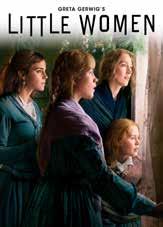
Whether you watch the movie or read the book, both put you in the fall mood because of its cozy vibes! Available to watch on Prime Video.
A go-to drink for the fall season! It’s a classic fall coffee with amazing spices. Add your favorite customizations, like cold foam or whipped cream! Go visit your closest Starbucks for a hot (or iced) cup!


A unique way to experience fall flavors! The best one is at Rise No. 1, offered only during the fall season.
The perfect mystery movie to curl up with some blankets and watch during autumn! Full of fall clothes and aesthetics, it is an amazing movie to watch soon Watch it on Prime Video.

Issued as Executive Order 10925 in 1961, the term “affirmative action” was coined by the government to improve employment, education and other opportunities for people who have been subjected to discrimination. Originally, in President John F. Kennedy’s order, this only ensured equal treatment to applicants “without regard to race, color, religion or national origin.”
President Richard Nixon later amended this executive order in 1971 to include gender within the range of groups.
In the following years, multiple undergraduate, medical and law students took separate universities to court, claiming the school’s admission process violated the Fourteenth Amendment’s Equal Protection Clause.
In 1977, the first case brought to the Supreme Court was Allan Bakke versus the University of California-Davis School of Medicine. Bakke, a 35-year-old white male, had applied to the California medical school twice and
was rejected both times. In UC-D’s affirmative action program, 16 of the 100 open spots for the entering class were reserved for “qualified” minorities. Bakke’s test scores and college GPA exceeded those of the “qualified” minorities for both years that he applied. So, he argued that his rejection from the medical school was solely based on his race. The Court ruled that colleges may not use quotas in the admissions process but allowed the continued use of race as an admissions factor.
On June 29, 2023, both Supreme Court cases involving the Students for Fair Admissions (SFFA) were decided, claiming the college admission processes of Harvard University and the

University of North Carolina violated the Equal Protection Clause of the Fourteenth Amendment. The Court’s ruling effectively ends affirmative action in college admissions.

Supreme Court.
“The thing that largely changed between previous cases and the most recent ones between the SFFA, Harvard and UNC was the makeup of the court,” Klassen said.
Senior Yoyo Yuan, CoPresident of the Asian Student Association, said the end of affirmative action may cause minority groups to experience even greater struggles when trying to enter college.
“I think it’s also important to value diversity in colleges because people benefit from having communities with multiple cultures,” Yuan said. “The stereotype for Asians may change a little bit. I hope that admissions officers will be equally fair in looking at Asian students’ applications without affirmative action.”
Yuan also discussed the bias surrounding students of Asian descent when applying to college, adding how admissions officers may reduce their racial biases in
lieu of the overturning.
Similar to their “lunchbox” meetings in the past, the Asian Student Association intends to discuss the impact of the ruling in the next few months.
Senior and President of the Black Student Union Alyssa Anderson believes the overturning of affirmative action is unfair, especially for people from disadvantaged backgrounds.
“There’s a lot of Black people in the United States who don’t have the access to the same resources that other races do,” Anderson said. “Affirmative action was that equalizer, and now that it’s gone, people aren’t able to showcase that they weren’t in the same situations as other applicants to admissions officers.”
Anderson added she personally has noticed that colleges have asked questions about how students will contribute to the diversity
of the campus, as opposed to asking directly about race as they had previously done in the past. Anderson also noted that affirmative action helped reduce bias against other groups.
“A lot of people say that if you say you’re a minority, people are more inclined to let you in to increase the diversity in colleges, but I can see how not including race eliminates some of the biases of application reviewers too,” Anderson said.
Currently, BSU has no plans to discuss affirmative action with their club members, but they may have later discussions.
Senior Olivia Zambrano, president of the Latin Hispanic Student Union, said that by overturning affirmative action, students now have difficulty in deciding to what extent they should talk about their race in their applications.
“The overturning of affirmative
In both cases, the majority was comprised of the six conservatives serving on the Supreme Court, with Chief Justice of the Supreme Court John Roberts writing the majority opinion for both cases. While the decision to end affirmative action in colleges’ admission processes was not a surprise, the extent to which race will be allowed in a student’s application is still up for debate. In the majority opinion of SFFA v. Harvard, Roberts said, “the student must be treated based on his or her experiences as an individual – not on the basis of race.”
Roberts explained how students may use their race in conjunction with a story highlighting their courage overcoming discrimination, or how their race motivated them to achieve certain goals and leadership positions. Therefore, while the check box signifying the race of individual was removed, there are still opportunities for colleges to acknowledge a student’s race in their decision.

action makes certain things harder for groups like Hispanic people who may not have had certain opportunities in the past,” Zambrano said.
However, Zambrano added that legacy admissions are also an important factor to consider when discussing affirmative action. According to the New York Times, Harvard legacy applicants make up only 5% of their applicants, but they are 30% of the student body.
“If you’re automatically admitting someone just because they’re a legacy student, that feels like a different part of the admissions process that most people aren’t thinking of,” Zambrano said.
Micah Lyles, Co-Director of College Counseling, said the ruling changes application questions.
“Simply, colleges can no longer ask students to check a box indicating their race,” Lyles said. “Applications still have a checkbox for data-collection purposes, but when it’s sent to colleges, they won’t receive that information.”
Lyles added that schools now include an extra question, allowing students to discuss their background in an essay. He added that one downside of the ruling is the way he hears students reflecting on it.
“I feel that some students feel like their identity is being undervalued,” Lyles said. “To me, the most apparent con that we see is the impact that it has had on students in how they perceive their identity.”
Lyles said that the actual effects of the ruling are to be determined. He added that because of the Court’s decision, he sees more students who are willing to write about their identity.
“I do think there is a tendency to misconstrue, and people assume it’s about college when affirmative action is so much larger,” Lyles said. “That’s some of the conversations we have with students, and we explain that there is no case where one factor is causing a student to
take a place from another student admissions.”
Lyles stresses the importance of researching before applying, something the College Counseling Team helps juniors with during the spring. He encourages students to visit the National Association for College Admission Counseling (NACAC) website, to learn about the ruling.
“Students are making their lists based on research,” Lyles said. “They will find places that value them.”
Lyles said that the immediate impact on the Hockaday College Counseling Team really consists of the time they are spending trying to understand the ruling and connect with college representatives about their stances.
“As far as our daily work with students, the overturning hasn’t changed anything,” Lyles said. “We are so fortunate here to have a process that is so individual that we sit behind these doors and help students fully represent themselves in their application, and we will continue to do that.”
Dr. Tracey Tevis, Director of Diversity, Equity and Inclusion at Hockaday, got involved with DEI (Equity, Civil Rights, and Title IX) initiatives during college. She has held roles throughout education groups, recently working in the DEI

office at Baylor University. She was working at Baylor at the time of the ruling, allowing her to observe the direct effects of what overturning affirmative action meant for colleges.
“We were having conversations at Baylor about the overturning,” Tevis said.
“For me at first, I was shocked when I heard about the Court’s decision.”
Tevis stressed the importance researching before forming an opinion, especially when it comes to polarizing topics.
“You can’t just look at TikTok,” Tevis said. “You need to hear both sides so you’re able to form an opinion.”
Tevis said students will still talk about how race plays a role in their lives if they choose to in their applications. She outlined how research shows that learning in places with diverse individuals helps develop skills like creativity and problem-solving.
“If you feel like your race, socioeconomic status, gender or age (or other identities) affect how you see or view the world, I encourage students to speak about these things because that makes you who you are,” Tevis said.

Even though the Supreme Court’s decision affects all universities with affirmative action programs, some states already banned the practice within their own public colleges.
After its 1996 ban on affirmative action, California saw a 40% drop in Black and Latino enrollment at UCLA and UC Berkeley. Additionally, economists who observed admissions at Harvard and UNC discovered that by removing their racial preferences, the number of Black and Hispanic students admitted fell.
While these are only two examples, most researchers
assume that the rest of the country’s colleges will follow this pattern and face a drop in racial diversity of their student bodies.

As for the future of the Supreme Court, along with lower courts’ decisions, Klassen predicts that this decision will cause an influx of new cases surrounding race-conscious admissions and determining the intent of a school’s acceptances or rejections.
Klassen said a Virginia case
working its way through the courts now may further impact admissions processes. At Thomas Jefferson High School in Viriginia, admission was largely determined by a test score. However, the school was not happy with their underrepresentation for Black and Hispanic students as well as low-income students and Englishlanguage learners. So, the school revised their admissions process to boost their diversity by limiting the consideration of this test score.
According to The Washington
this caused a dip in Asian American representation by 30%, leading a group of parents to file a petition for the Supreme Court to hear their argument that the high school’s new admission process racially discriminates against Asian Americans.
“So, this raises the question, can schools come up with something like limiting tests where they still can get the same result?” Klassen said. “It is going to be difficult for courts to determine the intent of a school and whether or not they appear to be making raceconscious decisions.”

“ “ “
When I see cute things,
I want to bite them.”
- Isa Moreno Form III

You really got that dog in you, huh?”
- Taylor Hua Form IV

We are not licking and sticking here.”
- Schuyler Long Form I

“
Thor gives major gigachad and Andrew Tate vibes.”
- Kimberly Zhang Form IV

An inside look at the new Assistant Head of Upper School’s daily life and habits.
In the wake of significant technological developments in generative artificial intelligence (AI), Upper School faculty members have dived headfirst into a portal to the future, introducing ways of utilizing these resources to aid in the classroom.
Head of Upper School Lisa Culbertson shared the revised Acceptable Use Policy, which now includes generative AI, with students at the Aug. 22 assembly. Students are now allowed to use AI with permission from teachers as per the Honor Code’s list of resources available to students.
Culbertson said upper school administration didn’t write an overarching policy yet, but are discussing what one could look like.
“It’s such a new technology for mass consumption, similar to the internet, and we haven’t figured out how exactly it should be used, whether by teachers or by students,” Culbertson said. “There’s still so many questions out there, and we didn’t feel like we knew enough for us to put out a policy that could be outdated within three months.”
Teachers can make their own decisions about how and whether to use AI in their own classrooms.
Culbertson said the administration wants teachers who are excited about AI and want to move forward with it to have the freedom to do so, and to teach students how to use it well. At the same time, they aren’t pressuring those who aren’t ready.
Upper School Technology Integration Specialist Candace Townsley spent her summer doing a grant study surrounding AI usage to learn the best ways teachers
can use programs like ChatGPT. Many companies have developed programs using similar algorithms to ChatGPT specifically centered around education, with features to help write word problems, create lesson plans and more.
Townsley said she also learned how students can properly cite chatbots if teachers allow its usage on an assignment.
them what it can do to optimize learning,” Croft said.
“AI was a really useful teaching tool for me.”
Lisa Culbertson Head of Upper School
“I understand both sides – if teachers want to use it or if they don’t,” Townsley said. “But I believe we are doing students a disservice if we aren’t teaching them how to use AI properly.”
At the beginning of the year, Upper School Faculty had a few professional development meetings to learn about generative AI from Luyen Chou, an educator and product and technology leader.
Neuroscience teacher Dr. Katie Croft was especially intrigued by the conversation, feeling an urge to teach her senior students how to use generative AI before they leave for college.
Although she has not allowed students to use AI directly on any assignments, Croft has started employ these technologies in her classroom by showing students examples of how ChatGPT works; for instance, she demonstrated how the chatbot “hallucinates,” or presents false information to users.
“ I believe we are doing students a disservice if we aren’t teaching them how to use AI properly.”
Candace Townsley Upper School Technology Integration Specialist
“I think a lot of my students didn’t realize hallucination was possible, which is why it’s equally as important to teach them about AI’s limitations as it is to show
Culbertson herself has experimented with AI in her new Financial Accounting class. Because it’s a new course, she needed to develop a syllabus and figured she could use AI to help. She had AI pull information together to create rubrics for different tests and asked it to give her questions about what she could ask students in her classroom.
“AI was a really useful teaching tool for me because it gave me more time to think about other kinds of exercises we could do in class,” Culbertson said. “It saved me a considerable amount of time by doing all of that work that would have taken me days to do.”
Students in the Financial Accounting class have no restrictions on AI usage other than needing to have parent permission if they are under 18, which is part of the U.S. government’s Children’s Online Privacy Protection Rules (COPPA) for websites and online services.
Culbertson isn’t the only teacher utilizing new technologies to enhance the classroom experience. Honors Law in American Society teacher John Klassen has been allowing his students to use ChatGPT to aid in brainstorming when coming up with Junior Research Paper topics.
“AI is just going to keep advancing,” Klassen said. “Even though it gets a lot wrong right now, it’s bound to keep getting better.”

On World Homeless Day Oct. 10, organizations spread awareness with projects, statistics and numbers to show the sheer scale of homelessness. But the biological effects of homelessness suffered by the unhoused are often ignored.
Research conducted on the homeless in America indicates that homelessness accelerates the effects of aging. According to the National Health Care for the Homeless Council, unhoused people die an average of 12 years earlier than the rest of the U.S. population due to the mental and physical toll of living without adequate shelter. According to NBC 5 DFW, more than 4,000 people in Dallas and Collin Counties were homeless in 2022. These individuals live in high stress situations, putting them at a higher risk of anxiety, depression, diabetes and cardiovascular disease.
A University of California, San Francisco study determined that homeless individuals with an average age of 57 recorded medical ailments, falls and heart attacks at numbers typical of housed people in their 80s.
With limited healthcare access, poor diets and close quarters in homeless shelters, minor illnesses – like a cold – can develop into serious complications if not properly taken care of.
“I think it makes the need for us to
help a lot more urgent,” Lola Barnard, senior and president of the Feeding the Need club, said. Feeding the Need works closely with homeless families in partnership with Family Gateway. “A lot of people don’t realize how urgent the situation is because they don’t know all the details.”
Cancer is a silent killer among the homeless population. Unhoused individuals are at an higher risk of developing various cancers due to increased exposure to substance abuse, infections, sun exposure and pollution. Little to no opportunities exist for the unhoused to get cancer screenings, so tumors often go undiscovered until it is too late. According to the American Society of Clinical Oncology, homeless people are twice as likely to die from cancer than the average U.S. resident.
Social Impact clubs like Feeding the Need and various service opportunities.
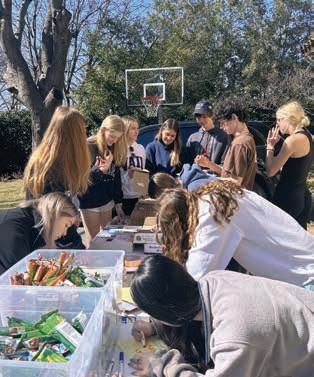
The Hockaday community works closely with organizations like Austin Street Shelter, Family Gateway, City Square and After8toEducate through
Barnard said the most difficult thing for people to understand about homelessness is that it is very difficult to escape because of the toll it has on an unhoused person’s mental and physical health, sometimes preventing them from finding jobs.
“I’ve been trying to educate people about these risks and the challenges of homelessness through my club,” Barnard said.
There are many opportunities for the Hockaday community to get involved, through events like Feeding the Need’s basket-making sessions that provide hygienic supplies for Family Gateway and upcoming opportunities on MobileServe, like the Feast of Sharing on Nov. 11.
Ending homelessness means creating suitable housing for millions and saving lives by consequently preventing and treating the potentially fatal effects of living without shelter.
Over the summer, many changes were made to the Writing Center: integrating a more prominent student aspect, planning to amplify their assistance and finishing their newly rearranged space.
For the first time ever, the Writing Center has a Student Director. Senior Ellie Browne became involved with the Writing Center last year, working with middle school students and spending most of her free time in the center. “I oversee the other interns and make sure that they are showing up when they need to and that they understand their responsibilities,” Browne said. “I often communicate when they need to show up for things.”
Her responsibilities include managing the heads of the newly established committees.
“We have different committees who are in charge of different outreach programs that the Writing Center is doing,” Browne said. “One of them is Reading with the Writing Center, where we host book discussions for Middle and Upper School.”
Each committee is involved with a different aspect of the Writing Center. There are five total committees: Writing Workshops, Middle School Mentors, Daisy Fiction Writers, Writing Contests and Reading with the Writing Center.
“We are working on a sentence structure workshop for lower schoolers,” senior Ryan Brown, Writing Workshops committee member, said.
expanded its services to Middle School, and this year it is extending its assistance to Lower School.
“Working with Lower School will be so exciting,” Cothren said. “We are going to have workshops, and
year,” Browne said. “Dr. Wohlgehagen, who teaches eighth grade math, is going to send his students to us to help them with math writing.”
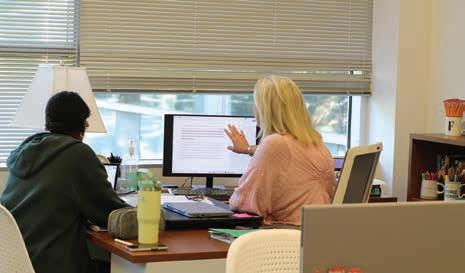
“ We have discussed the possibility of helping students in Film with writing scripts for their upcoming films.”
Dr. Claire Cothren Writing Center Faculty
Last year, the Writing Center fully
eventually we are hoping to do one-on-one sessions.”
Using writing workshops to help lower school students, the Writing Center aims to do more than just help students with English papers.
“Hopefully the tutoring can not only prepare students for writing generally, but also for taking STAAR tests,” Cothren said.
Pushing through barriers, the Writing Center has also expanded to other departments. Previously, it focused on helping students with English and History, but after talking with teachers and department chairs, tutoring will include writing in other subjects.
“We are branching into new departments this
The Writing Center is also trying to work with Fine Art courses as well as helping with out-of-school opportunities.
“We have discussed the possibility of helping students in Film with writing scripts for their upcoming films,” Cothren said.
Overall, the Writing Center’s focus is to help all students by involving them in the process to ensure the best possible outcomes.
“We always wanted the writing center to be student-led, have students be the face of the writing center,” Cothren said. “We made it a goal to delegate even more responsibility to students.”
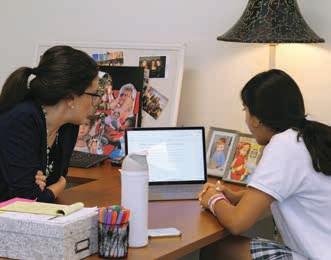
head with many
Scott Bowman took on the role of Assistant Head of Upper School this year. He first joined Hockaday as an Upper School History teacher in 2020. He taught the United States Government Social Impact class offered served as Assistant Rowing Coach.
EXPERIENCE | Bowman began his teaching career at the Salisbury School in Connecticut and went on to teach writing composition at Rutgers University-Newark, legal writing at Fordham Law School and labor law at Pennsylvania State University. He also served as an Adjunct Associate Professor at Fordham Law School.
6 A.M.
RISE & SHINE | Bowman occasionally catches an early morning workout. On those days, he’ll start his day around 5 to 5:30 a.m. He’ll have a coffee on his way to school, but sometimes he treats himself to a decaf iced latte. After dropping his children off at their school, he arrives at Hockaday to start his busy and sometimes unpredictable day.
4 P.M.
AFTER SCHOOL EVENT | A dedicated champion for his students, Bowman typically attends at least one after-school event, whether it’s soccer practice or a cross-country meet. He makes a conscious effort to support his students outside of the classroom, often showing up to their games to cheer them on from the stands.
11 A.M.
CATCH-ALL TIME | Bowman makes time to remain visible and available to all students. “I want to remain receptive to feedback and suggestions as I settle into this new role,” Bowman said.
He typically meets with other Upper School administrators during this time but tries to prioritize time for conferencing with students and addressing any concerns.
8:00 A.M.
SCHOOL DAY STARTS | He prepares for the day’s meetings and remains ready to tackle anything and everything that’s needed. “Every day looks a little different considering the new position I’m in,” Bowman said. On the days when he teaches his Law in American Society class, he usually spends the morning preparing for those lessons, leaving time to meet with students as the need arises during the week.
5 P.M.
HOME TIME | Bowman wraps up the day by making dinner and spending time with his family while enjoying some relaxation time.
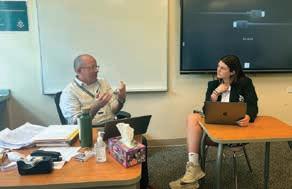
10:25 A.M.
ADVISORY | Serving as a senior advisor, he hosts his advisory in his office on the first floor with his new co-advisor, Randal Rhodus. His advisees praise his genuine interest in their lives and how connected they feel to him. Their advisory has been together for all four years of Upper School. “Mr. Bowman has been one of the most supportive faculty members I have encountered in my eight years at Hockaday,” senior Zoe Stone said. “In some ways, I feel like I have grown up with him.”
8:45 A.M.
E PERIOD | Bowman teaches Law in American Society during E period. At the beginning of every class, he leads students through a mindfulness ritual which allows them to start class on the right foot with a focused mindset. He feels this exemplifies the motto, “work hard when it’s time to work and rest when it’s time to rest.” He explains that he makes a deliberate effort to “incorporate one to two formal breaks during the period.”
EDUCATION | Bringing a unique background, Bowman earned his Master’s of Fine Arts in Creative Writing at Rutgers University and a Bachelor of Arts in History at Brown University. He holds a J.D. (Juris Doctor) degree from Fordham Law School and practiced as an attorney for several years.
With flashy, neon, graphic pages, Emporio’s magazine covers immediately attract attention.
Emporio is a student-led club whose mission, inspired by a passion for entrepreneurship, is to cover stories about leaders, specifically women, in business and nonprofit organizations worldwide.
Founded by junior Celine Ebert and alum Liya Chen ’23, the magazine is designed to give unique perspectives about the field of business and to create an impact.
“The whole idea is to create a community of likeminded women so that they feel empowered enough to pursue business as a career and break through barriers,” Ebert, the club president, said.
Their main way to convey this message is through their publication, Emporio, which has won awards such as the Columbia Crown Award for General Print Magazine. Originally published once a year, the club leadership’s new goal is to publish the magazine biannually. Each magazine features around 12 articles, written around a common theme.
The latest edition, Breaking Barriers: Emporio Magazine Volume 2, focuses on the barriers women have broken despite discrimination and difficulties. It features Hockaday-centered pieces articles like “Career Preparation,” which discusses Hockaday’s role in readying women for a potential business career, and “Maddie Bradshaw’s Journey with MP3 designs,” a profile on Hockaday alum Maddie Bradshaw ‘14.
It also includes articles about women pioneers worldwide like Youth Business in Sub-Saharan Africa and Mujeres Creando: The Feminist Anarchist Movement, which discusses a feminist movement that started in Bolivia in 1992. It also features articles ranging from the role of women in baseball to finance to beauty. The most recent Emporio edition is reflective of its predecessors:
it offers a diverse range of topics that are still woven together by a common motif.
It also aims to offer learning opportunities for both its readers and its writers.
“One reason I love Emporio so much is that I get to learn a lot about different topics, while also being given the opportunity to help educate other people. It’s a great
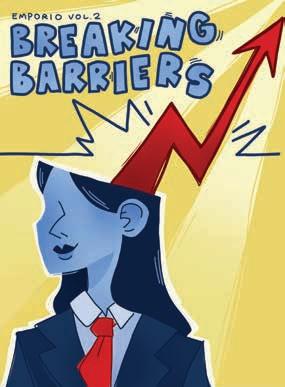
way to learn about the world around me,” Kushi Gohel ‘25, staff writer, said.
The magazine stays true to the interests of the younger generations by being fully staffed and operated by Hockaday students.
“[Emporio] came from students and is directed by students,” club sponsor and Upper School English teacher Sara Harder said. “They come up with all the ideas, so it really reflects the passion and interests of the student body.”
In addition to the online magazine publication, Emporio also records podcasts, available on Spotify. These feature interviews with prominent businesswomen such as Mandy Ginsberg ’88, the current CEO of the Match Group, and Jaqueline Sewell ’99, current managing partner at Sewell Automotive Companies.
“With our podcast, we work to highlight influential women to show the potential of a business career,” Ebert said.
In the future, the Emporio club aspires to expand their impact by hosting entrepreneurial workshops for local middle school girls. The workshops will teach participants what it means to work in the entrepreneurial field. In the workshops, they will get to design their own business models and create prototypes for their ideas.
Emporio is also planning an exciting new speaker series centering on prominent businesspeople to draw more attention to the career. Currently, they have lined up Katie Leto, the CFO of Hockaday, to speak to both Emporio and the Investment Club. They are also planning events with other prominent businesspeople in the Dallas community.
Overall, Emporio hopes to continue to expand and spark interest and inspiration in girls across the community to become interested in business.
Listen to the Emporio’s podcast here!
Roles have changed in Hockaday’s college counseling department as a result of a new hire and a position change.
Former College Counseling Associate Allison Camp was recently named Associate Director of College Counseling.
Last year, Camp was stationed at the welcome desk in the common area of college counseling. Now she has her own office, and a little more peace and quiet.
“I love my new office space because I can have some more privacy, but I do miss the energy of my old desk,” Camp said.
In addition to a change in office location, Camp now works with significantly less students at a time.
“I used to run testing, such as AP tests and the PSAT, for all grades in the Upper School, but now, I only have a caseload of 35 students,” Camp said.
Camp now works as a full-time college counselor, helping students through the admission process. Camp said she likes her new role, and the adjustment was not difficult.
“The transition was amazing because I feel like I already knew the students on my caseload,” Camp said. “I already got to see many students regularly just from
sitting out at my old desk and having them in resume meetings.”
To fill Camp’s previous position, new hire, Aspen Arnold, has stepped in. Arnold previously worked for Michigan State University as a Regional Admissions Counselor. She worked remotely from Dallas, so physically coming to an office was a positive shift for her.
“It’s really nice to have a stable routine,” Arnold said. “I get to get dressed in the morning and come to an actual office space.”
Arnold was familiar with the Hockaday College Office and was looking for a more face-to-face work experience; both factors impacted her decision to work at Hockaday.
“Before this job, I only got to know students as applicants, but here I get to have a more personal relationship with the people that I work with,” Arnold said.
Elizabeth Jones, Director of College Counseling, said there is a fresh energy in the office, and she is excited for what the next year holds.
“With the new changes in the office, there is so much positivity everywhere you go,” she said.

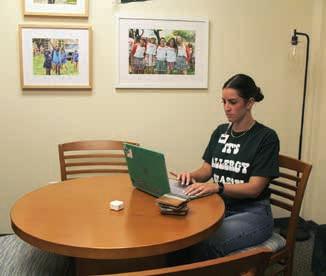
Athlete Spotlight: Abby Grace McGowan
Rower talks success at USRowing Nationals, beginnings in the sport and team culture
Whether the Hockaday Hypewomen are posting about upcoming sports events on their Instagram (@ HockadayHypewomen) or cheering in the student section at athletics events, they always have one common goal at the forefront of their minds: give all Hockaday athletic teams the recognition they deserve.
Seniors Reese Dondero, Amalia Evans, Julia Small and Leila Tarighi are the Hockaday Hypewomen this year.
To be chosen for the job, Dondero, Evans, Small and Tarighi submitted video applications at the end of junior year. The Athletic Board and previous Hypewomen then selected the best fit candidates.
Small, the lead Hypewoman, is responsible for the organizational side of the group and acts as the point of contact with the Athletic Department.
“I reach out to Coach Surgi and Coach Johnson and make sure jobs are distributed and games are covered,” Small said. “Collectively, we all work in unison to create a social media page that is personable for students to watch.”
The past Hypewomen noticed it was difficult to have enough coverage with only two Hypewomen, which is why they chose to expand the number to four this year. To make sure they get the coverage they need while still balancing their schoolwork and extracurricular activities, the Hypewomen have set a system in place.
“We map out a schedule at the beginning of the week so that we can coordinate homework around our responsibilities as Hypewomen,” Dondero said.
As Small takes on her lead role, she looks to the leadership of Ava Tribolet ’23 and Landry Grover ‘22, who were the first two lead Hypewomen.
“I see that they’ve led in different ways, so I’ve been able to watch them and their styles, but it’s also nice to know there is some creative freedom,” Small said.
As Hypewomen, they are responsible for providing coverage for Hockaday athletic events, attending home games, leading pep rallies and making sure their social media is fun for viewers.
“We encourage support at games and are connectors of the student body, urging students to show up to games,” Small explained.
During games, they lead cheers to get the fans involved, and Tarighi believes the Hypewomen strengthen the sense of community and belonging within Hockaday Athletics.
“It’s super fun to see athletes looking up at the stands to a big crowd,” Tarighi said. “This is one of the intangibles that the Hockaday Hypewomen provide to make the program special and unique.”
This year, they also strive to create more
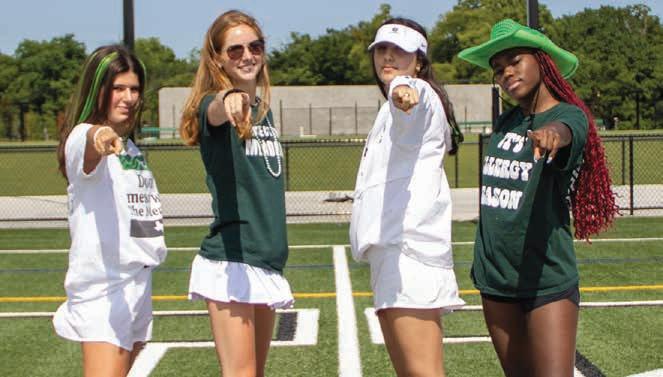
enjoyable environments during games with cheers, free merchandise and food.
“Because we have four Hypewomen this year, we are able to make more of an impact working together,” Small said.
The Hypewomen have noticed a lack of information on certain sports, so they aim to foster spirit across all sports and encourage St. Mark’s students to support Hockaday Athletics.
According to Small, the Hypewomen’s roles extend to telling teams’ stories, reporting on their games and posting on social media for sports that people would not typically see.
“The goal of the Hypewomen is to bring the spotlight to other sports that don’t usually get much attention,” Dondero said. “Hockaday athletes love having more recognition and attention for all of their achievements, especially when they’re at SPC, to know that people are watching back home.”
Evans agrees with Dondero and believes that the Hypewomen strive to recognize every sport.
“Every sport gets a chance to show their achievements, games and everything they do, so the teams in the shadow have chances to be brought to light,” Evans said.
Beyond Hockaday, the Hypewomen and their Instagram account help keep Hockaday graduates, friends, families and even opponents connected
to Hockaday Athletics updated on teams’ journeys throughout each season.
To Evans, the Instagram account reflects the Hypewomen’s core value to uplift everyone, as they believe that all teams and players deserve to be recognized, no matter their role.
“People look at the Hockaday Hypewomen Instagram before they come to the Meadow to gauge what the happenings are and how certain teams are doing,” Tarighi said.
Evans, only a few months in the role, has already obtained an important life lesson. “You never know the impact you have on people when you do the smallest things; the impact on someone’s life could be bigger than you expect,” Evans said.
To Dondero, being a Hypewoman is a very meaningful experience.
“I’m really glad that I get to represent the Hockaday community and play a part in helping school spirit and support the athletic community because – as girls – our sports often come second to men. I like being able to bolster our reputation, coverage and attention that we get,” Dondero said.
“It is a privilege and an honor to be a Hypewoman and very cool to know that people will look at what I’ve done, grow from it and impact athletes,” Small said.
Ahead of the announcement of the Daisy Mascot’s name at the Spirit Rally on Oct. 27, one of our Editors-in-Chief sat down for an exclusive interview with the person behind the mask.
Q: What is your favorite thing about being the Daisy?
A: I would say just getting to be a character that is not necessarily myself. I can be whoever I want to be when I’m wearing the costume because nobody knows who it is.
Q: How does it feel to represent Hockaday?
A: Amazing. Hockaday and the Athletic Department are such important parts of my life and it’s amazing to be able to be the face of that. It’s awesome to see everyone’s excitement about having an actual mascot and being represented in a way that feels tangible for everyone. It’s pretty eye-opening seeing everyone else’s excitement and
passion about athletics and their spirit for Hockaday.
Q: How do you think you contribute to the Hockaday Athletics atmosphere when you show up at a game or Spirit Rally?
A: I feel like there’s more of a sense of something to fight for in everyone because they see the Daisy and are like: ‘Oh that’s the Daisy! #ProtectTheMeadow at all costs!’ So, it’s great to feel the atmosphere and see everyone wanting to win.
Q: How important do you think a name would be for the Daisy Mascot?
A: It would be amazing for everyone around the school to be able to call the Daisy by its name because then it’s no longer just an object, and it’ll have an actual identity that everyone can rally around.

Moments before a stressful meet, girls stretch and run laps to warm up, however, the key factor to performing their best is to train their minds. No matter how strong your muscles are, a healthy mindset is the first step towards success.
Sports psychology consultants Matt Gutierrez and Brooklyn Wascom aspire to help athletes achieve this mentality.
Last year, Hockaday partnered with the University of North Texas to teach student-athletes about sports psychology and its importance. The program began with just one consultant last year, but expanded this year with the addition of another consultant, Wascom. Gutierrez and Wascom strive to help teams build their mental performance from team bonding activities to pre-game meditation.
Last cross country season, Gutierrez taught the team exercises to relieve pre-race anxiety together. Their first activity was running with a piece of paper that represented their pre-race thoughts and how to let them go. Such activities help the girls visualize their obstacles and overcome them.
“I get really nervous for races and never fully get rid of my nerves,” sophomore Finley Starr said. “Honestly, having fewer thoughts and knowing I’m just going to a cross-country race was very helpful.”
Before diving into a session, Gutierrez and Wascom observe the dynamic of a team and get feedback from both the coaches and athletes on what skills they think might be best to work on and develop.
“We help build psychological skills so that when
they’re in a game and performing in a high-stress situation, they have the tools they need to center themselves, remain focused, and get the job done,” Wascom said.
Whether it’s getting rid of pre-race nerves or being able to stay calm during an important game, the coaches have a lesson prepared for all situations. The sports psychology program’s focus is to ensure that athletes are mentally as strong as they are physically.
“Mindfulness can be an incredibly valuable psychological skill.”
-Brooklyn Wascom
“We’re hoping to teach athletes different psychological skills to implement both individually, and at the team level so that they can thrive on the field or on the courts,” Gutierrez said.
Gutierrez and Wascom want to educate studentathletes about how the skills learned in sports psychology translate to everyday life as well.
“Whether it’s in practice, in a game, even just at home,” Wascom said, “mindfulness can be an incredibly valuable psychological skill.”
While sports may seem to be completely physical, it is also a mental climb, and Gutierrez and Wascom have been crucial in helping young athletes train their minds so they can apply these skills for the rest of their sports careers.
While the competition on the court was intense, Varsity Volleyball enjoyed strengthening team bonds off the court while in Las Vegas for the 2023 Fall Durango Classic.
The tournament is one of the most prestigious in the country. Hockaday was one of three private school teams representing Texas at the tournament which took place from Sept. 22-23.
Allison Camp, assistant coach and trip organizer, designated roommates two months before the tournament, ensuring each group had sufficient time to prepare for the weekend’s most important event: a popular culture skit competition, judged by Camp and Head Coach Andy Gass.
Athletes packed extra suitcases full of props and costumes, wrote scripts and mixed music to accompany their performances. Senior team captain Avery Jackson, who roomed and performed with senior team manager Amalia Evans and freshmen teammates Mila Haffar and Siena Ebert, said this was her favorite part of the weekend.
“On Saturday night, every room performed their skit and we all died of laughter,” Jackson said.
According to Jackson, it is so rewarding to dedicate time away from volleyball to have fun and laugh with the team.
“There’s no shortage of off-the-court fun with this group,” Camp said.
The team’s ability to let loose would be impossible without their on-the-court grit, determination and dedication. Statistically, the team played the best volleyball of their season at the tournament, winning the Competition Division to finish 25th out of 65 teams. Jackson was named to the All-Tournament team.
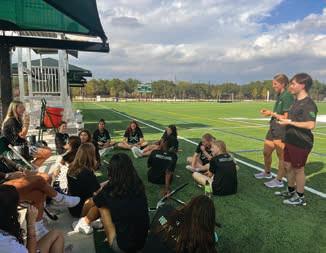
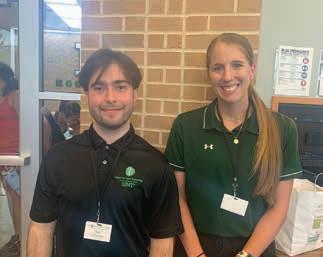
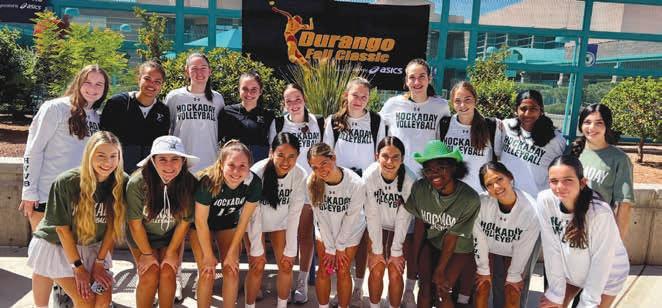
“Things really clicked for us against the best teams in the nation,” Camp said. “While high-stat games like these are always good to see, we tell our girls that individual successes aren’t possible without our collaboration, teamwork and team culture.”
Freshman newcomer Haffar said she thought it’d be difficult for her to integrate herself into the group, but soon found out this was not the case.
“This team is just so welcoming, I think because we have so much in common, I just fit right in,” Haffar said.
From player to player, coach to coach and player to coach, trust, value and respect for each other are three things Camp said are what build on-court
chemistry and help players through tough games.
“During those nerve-racking moments, as a team, we just lock in and all help each other through that,” Haffar said.
Any time spent together, from three-hour plane rides to Nevada or a five-minute bus ride to Ursuline, also helps them connect. For this team, the more time spent together, the better.
“We got back to Love Field and wished the tournament was longer,” Camp said. “We have so much faith in them, and I think sometimes they think we just care about them, but this weekend was mainly eye-opening for them and what they’re capable of.”
Breathing hard and ignoring the pain in her legs, senior Abby Grace McGowan pushes her feet against the foot stretcher in the boat and takes the last few strokes of her race at the USRowing Summer National Championships on July 16 in Bethel, Ohio. After crossing the finish line first in the 2,000-meter race, McGowan slaps the water in celebration.
McGowan is one of Hockaday’s two rowing captains and recently won two races at the USRowing Summer National Championships in a quad and straight four, as well as winning second place in an eight with girls from all around the country at the Ready Set Row Elite racing camp.
She also won fourth in a straight four with Evie Fox, Zoe Stone and Savannah Frederiksen at the USRowing Youth National Championships.
McGowan was a cheerleader in the fall season of freshman year. Encouraged by her older brother, who rows for Cornell, McGowan first decided to give rowing a try during the spring season.
“I saw how much of an impact it made on his life,” McGowan said. “So, I thought, ‘Why not? I don’t have a spring sport.’ And that’s how it all began.”
To achieve excellence in rowing, rigorous training is non-negotiable. McGowan’s training regimen blends on-the-water practice with erg
workouts on land, designed to match the specific demands of each race.
“As a rower, it’s crucial to adapt your training to the type of race you’re preparing for,” McGowan said. “For head racing, it’s about steady state on the erg and working in harmony with the boat. For sprint racing, it’s all about interval pieces, both on the erg and in the water.”
Head Rowing Coach William Forteith said McGowan brings joy to the lake.
“She loves to row, she loves to race, but, above all," he said, "she loves to train and to bring others along with her as we, as a team, strive to be faster.”
Assistant Rowing Coach Maria Esway emphasizes McGowan’s inclusiveness to all form levels.
“She really has patience for people who are learning,” Esway said.
McGowan said her favorite aspect of rowing is the feeling that washes over her after a race.
“I’ve never had a race where I came off and thought, ‘I could have pushed harder,’” McGowan said. “It’s that feeling of giving it your all, and it’s exhilarating. I always have fun.”
Esway said something that sets McGowan apart is her work ethic.
“She doesn’t see obstacles,” Esway said. “If she wants to do something, she does it.”
Forteith said he looks forward to seeing McGowan bring the same sense of competitive joy to her future teams, creating a positive

culture around self-improvement and supporting others.
As captain, McGowan looks forward to making plans for her team, aiming to strengthen the bonds among her teammates.
“I want to take everyone to the State Fair this year," McGowan said. "Our team is already full of energy, and who knows what will happen when we all go to the State Fair together?"
McGowan said her goals this year are to secure a spot on the podium at the USRowing Youth National Championships in the straight 4 and achieve a top 10 finish in the coxed quad at the Head of the Charles regatta this October.
Check out what our athletes are up to this fall
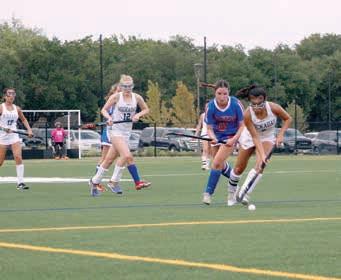
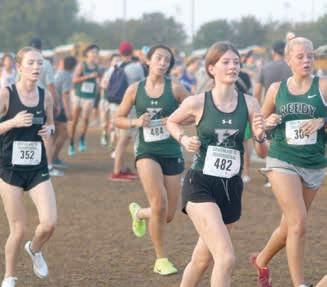

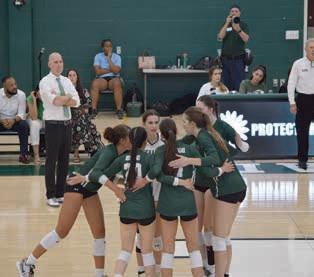
A newer and safer Texas?
New gun bill passed in Texas. Staffer reflects on what that means for her.
As I step into school every day, walk into the mall, or even get a quick bite to eat with family, there is always a lingering thought: “What if this casual, everyday event turns into a nightmare like the ones seen on the news?” While the thought slowly takes over my brain, I frantically look for illuminated exit signs or small places I could hide.
Sadly, these occurrences have become the norm for Americans today in the heightening epidemic of mass shootings. Often, I feel as though I am desensitized to the headlines of yet another mass shooting because it feels like it happens every day. While it is important to recognize the victims, it is just as important to recognize the legislative change that must occur against semi-automatic rifles, especially with the sad events that happened in Uvalde and Allen.
While I am a strong believer in the Second Amendment, I believe there
must be guidelines for those who want to purchase guns. This includes deeper background checks, mental health assessments and age. Although I think these standards should have been put in place a long time ago, Texas is now taking a small step forward with House Bill 1760.
HB1760 restricts the possession of firearms on premises “owned by, and under the control of, a school, or locations, where high school, collegiate and UIL activities are taking place.”
This new bill will benefit Texans. The limit includes off-campus events and public buildings like a prom location. Although I think this bill is a step in the right direction, there are questions

about how the law will be enforced.
Who run the world
Staff editorial on women’s impact on the economy this summer.
House Bill 3137 prohibits governments from requiring gun owners to have liability insurance. In contrast to HB1760, HB3137 is a disgrace to all efforts made nationally to prevent mass shootings. Liability insurance, required in New Jersey and San Jose, California, covers negligence or accidents that could occur. Gun liability is imperative because it forces the practice of gun safety, allowing gun owners to avoid high fees or losing insurance coverage. As Texas is taking one step forward and three steps back with the passing of new bills, it is important to recognize the impact that our representatives have.
While it is too late to pass new bills this legislative cycle, it is important to ensure that your representatives also speak for your values and priorities. Call or email your local representatives, like the mayor and city council members. Lobby for the person that will help Texas be a safer place for our little siblings, our little cousins and our future kids.

Transitioning to the whopping 100-minute classes seemed like an absolute death sentence last year when the announcement was first made. However, after a few classes this year, 100 minutes doesn’t feel that much longer than the 80 we are used to. In fact, it has been nice having extra time at the end of class to connect with teachers or classmates or to ask final questions instead of rushing to get to the next class.
Though I know we are all busier than ever, the pace just feels a little less frenzied in the hallways. I feel I’m not sprinting from one class to another like I was last year. The precious few extra minutes to rub the sleep out of my eyes before the first class of the morning or to reset after a particularly hard test from a previous period has certainly been a plus.
I’ve also heard several positive things from teachers about the new schedule. The science teachers have appreciated being able to execute more in-depth labs. Some teachers also mentioned that the extra 20 minutes allows them to explain difficult topics more thoroughly or work with students on an individual basis without having to make a separate appointment. For students with accommodations, the 100-minute stretch has also helped to administer assessments continuously without having to break up tests into two periods or two separate days.
I have noticed more in-class writing time in my English and History classes, which has lightened the homework load from late-night papers. Although I feel I still have just as much studying to do after school and getting out a bit later hasn’t helped that, the time I do have can be spent studying rather than finishing up homework assignments. If all teachers begin to implement this and are present to answer questions, it’s a win-win situation and I think more students will appreciate that.

It’s too early to tell, but I believe the 100 minutes will feel physiologically more normal over time as anxiety levels come down. I learned that our attention spans follow a predictable “ultradian rhythm,” similar to the normal circadian rhythm we experience over the course of day and night. The ultradian rhythm peaks and wanes over approximately 90-100 minutes. Having this time without interruptions can increase focus during the “on” periods if they are interspaced with intentional rest periods. Most courses have already varied the agenda of their classes to enhance the collaborative, kinetic, and hands-on components of class time. There is much potential to build on that. I know our school administration has gone to great lengths to consult formal research and expertise on the matter – now it’s up to us to approach it with open minds and voice constructive feedback as time allows.
Hockaday’s new 100-minute classes may allow for a longer period of time to spend on one subject, but they are also a huge adjustment for both students and teachers.
At the end of the day, I find myself struggling to keep my eyes open after already sitting through two straight 100-minute instruction periods. The last class of the day seems to last forever, especially for someone like me who struggles with paying attention for long periods of time.
Part of the reason the new 100-minute classes are so hard to sit through is because no one has adjusted to them. Changing the daily curriculum to fit the 100-minute format has proven to be a challenge in many subjects. In some of my classes, it feels like teachers are trying to cram too much into one class period because they weren’t sure how much work would take up the entire class. In others, I feel like we don’t do enough – we do one lesson that would have engulfed the entirety of a 75-minute block, but not a 100-minute block.
But, when too much information is crammed into a 100-minute class period, it is difficult for me to remember everything we’ve discussed or remember all the work I need to do for the next class. When I get home, I have to study several topics, which gets very confusing very quickly.
Some classes simply cannot have 100 minutes of instruction. For example, I feel there is only so much calculus a student can learn in one class without becoming overwhelmed. Thankfully, my calculus teacher has been diligent about giving my class a little time at the end of every class to get started on homework or ask questions. Other people I have heard from have not had this experience in class.

When the latter happens, it is usually easier for students to handle because they learned an adequate amount of information for one class period, and this gives them an opportunity to start homework.
For teachers, the new rotation schedule means that any class in the last block of the day will not happen again for two entire school days, making continuous curriculum and teaching a challenge.
Altogether, the new 100-minute schedule is hard to keep up with and can be a struggle for students who already have problems staying focused for long periods of time. Although I appreciate that we have fewer classes every day, it hasn’t meant I’ve had less homework – I just have more instruction and, because of that, more studying and reviewing to do at home.
We

Halloween is just around the corner! Students are coordinating costumes with their friends.

The big dance of the year is finally approaching, although some may have struggled to find dates or navigate other commitments.

The hundred-minute classes have taken a while to get used to, but students are finally starting to adjust.

Students are struggling to study for assessments after the long summer break.
fEDITORS-IN-CHIEF
Kailey Bergstedt, Caroline Bush, Harper Harris & Bennett Trubey JADE EDITORS
Aadya Kuruvalli & Melody Tian WEB & SOCIAL MEDIA EDITOR
Hanna Asmerom
NEWS EDITOR
Amitha Nair
ARTS & LIFE EDITORS
Alexandra Dassopoulos & Alexa Muñoz
FEATURES EDITOR
Danya Risam-Chandi
ASSISTANT WEB AND CENTERSPREAD EDITOR
Anjy Fadairo
SPORTS EDITOR
Elizabeth Truelove
OPINONS EDITOR
Shreya Vijay
PHOTO, GRAPHICS & CASTOFF EDITOR
Elle Myers
STAFF WRITERS
Larkin Clouston
Shifa Irfan
Cece Johnson
Anya Aggarwal
Caroline Ballota
Jessica Boll
Lang Cooper
Melinda Hu
Audrey Liu
Sophia Lou
Emily McLeroy
Sarah Moskowitz
Leyah Philip
Anika Shah
Mary Bradley Sutherland
Aadhya Yanamadala FACULTY ADVISER
Kristy Rodgers
The Fourcast is written primarily for students of the Hockaday Upper School, its faculty and staff. The Fourcast has a press run of 1,200 and is printed by Midway Press. It is distributed free of charge to the Hockaday community. The staff reserves the right to refuse any advertising which is deemed inappropriate for the Hockaday community. Opinions will be clearly marked and/or will appear in the views section. Commentaries are the expressed opinion of the author and do not necessarily reflect that of The Fourcast staff, its adviser or any other member of the Hockaday community. The Staff Stance on the views page reflects the position of The Fourcast staff, but not necessarily the position of the Hockaday administration or community. The Fourcast staff determines the content of each issue and strives to work as independently as possible in producing the student newspaper, but the content is subject to prior review by the head of Upper School, the communications director and other members of the Hockaday leadership team. Letters to the editor and guest columns are welcome and should be addressed to the editor-in-chief. Only signed pieces will be published. Corrections and clarifications from previous issues will be found as designated in the news section. Any questions or concerns should be addressed to Editors-in-Chief Kailey Bergstedt at kbergstedt24@hockaday.org, Caroline Bush at cbush24@hockaday.org, Harper Harris at hharris24@hockaday.org or Bennett Trubey at btrubey24@hockaday.org.
The staff editorial is an unsigned piece representing a consensus of opinion among members of The Fourcast editorial board regarding a current issue.
From Margot Robbie and Greta Gerwig to Beyoncé and Taylor Swift, this past summer was one of artistic talent and success for women – but more importantly, it was the summer women dominated the economy.
Not only have we seen a rise in successful businesswomen, as exemplified by these entertainers, we have also started to recognize the power of women in driving economic growth.
With Barbie’s $1.38 billion in ticket sales, Greta Gerwig is now the highest grossing female director in U.S. history.
The star-studded movie gained traction through a press tour in eight cities across the world, new Barbie merchandise and collaborations with a myriad of brands, from NYX Beauty to Fossil.
Another woman breaking records in the entertainment industry, Swift has fueled the passion of her friendship-bracelet wearing fans throughout her “Eras Tour.” By the time it ends in August 2024, Swift will have completed 146 concerts – and according to CNN, could possibly make up to $2.2 billion in North American ticket sales alone.
proven their major economic influence.
In the past decade, there have been cultural and economic shifts allowing women to make purchases unrelated to the home – and instead, spend disposable income on joy-fulfilling products or experiences. Women did just this over the summer, stimulating local economies in the process.
Loyal consumers will continue to pur-
together this summer and spend? And what is really propelling the success of businesswomen? The answer is authentically relatable marketing.
Even though the goal wasn’t necessarily activism, the big-ticket entertainment events of the summer were made by women for women: they illustrated experiences we all share, connecting to us on a deeper level in an empowering way. What we saw was more than just tactics to cater to women. It was authentic –and marketing like this not only uplifts women, but also benefits the entire economy.

Additionally, Beyonce’s electric “Renaissance” Tour has captivated the “BeyHive” since May, with Forbes estimating she might rake in even more than Swift. Recently, at AT&T Stadium, female ticketholders led the way in spending on everything for the Queen’s Concert, including metallic clothing, ride shares, food and drinks.
Aside from this obvious female business success, it’s the spending power and multiplier effect of women that has

son who has five of the same tops in different colors. Similarly, women at Barbie, “Renaissance,” and the “Eras Tour” bought tickets, only to return with different groups of family or friends, exponentially driving up spending in a process called the multiplier effect.
So, despite persistent stereotypes regarding women and money from male counterparts, women today have more disposable income, greater control over family finances, and evidently, the ability to generate enormous economic growth.
But what drove women to show up
To continue the progress for women in business, we believe that authenticity and relatability must be at the heart of marketing. But this goal means more than simply advertising to women to make a quick buck. We want to see businesses that both invest in female leadership and who have a genuine passion to support or represent women in a modern world.
We also believe that structural issues in the economy must be addressed. Historically, women have faced more difficulties in funding their business ventures, and as a result, they tend to stay smaller and take fewer risks. As we inspire the next generation to break into a male-dominated industry, we must look to successful female mentors for support, in the face of these predictable, financial setbacks.
So, to all the ladies, don’t be afraid to exercise your economic power, because our spending drives change. Whether it’s buying products that make a political statement, supporting female-owned business, or investing in companies that you find both appealing and empowering, we encourage you to flex your economic muscles.
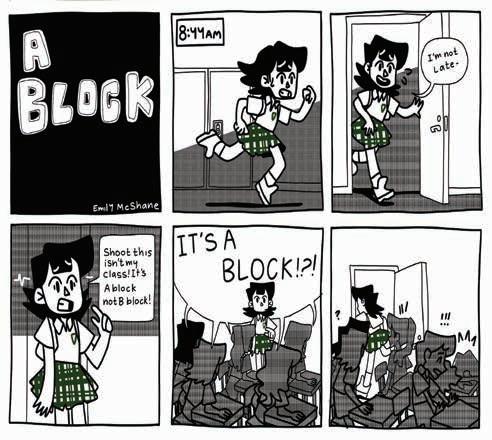

Each year, every senior gets a personalized baseball inspired jersey with a fun nickname on the back allowing them to show their unique personality.
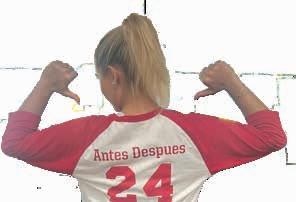
Erin Antes
“My last name is Antes which mean ‘before’ in Spanish and Despues means ‘after’ so my shirt means “before and after.”
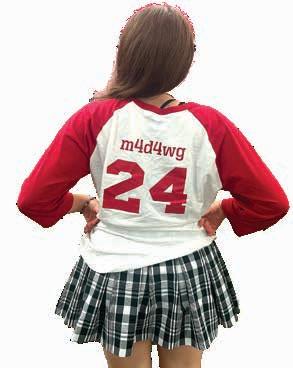
Madelyn Neuhoff
“It was my Fortnite and TikTok username. The 4’s are A’s.”
By Elle Myers Castoff Editor
Anisha Sharma
“My childhood nickname is Boojoo. There is a book ‘The Nunga Punga and the Booch.’ My sister is called Nunna Bunna, and I’m called Boojoo.”

Margaret Thompson
“This was a slogan I used on a campaign poster, and it was catchy, so it stuck ever since.”

Gupta
“A friend calls me Train Goop and thought I should put it on my shirt.”

Magriet Cordero
“One of my fellow advisees started calling me it freshman, so it was fitting to put it as my name.”